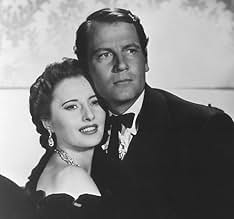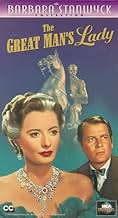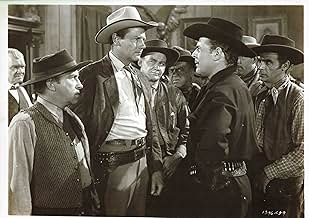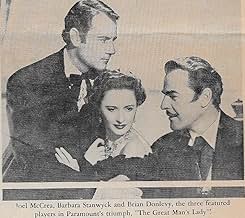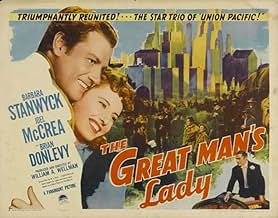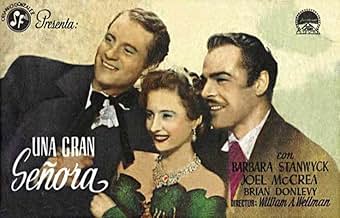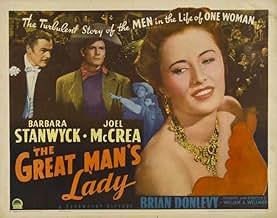A 100-year-old pioneer woman tells her story in flashbacks.A 100-year-old pioneer woman tells her story in flashbacks.A 100-year-old pioneer woman tells her story in flashbacks.
- Awards
- 2 wins total
K.T. Stevens
- Girl Biographer
- (as Katharine Stevens)
Irving Bacon
- Parson
- (uncredited)
Hank Bell
- Man #1 - Hoyt City
- (uncredited)
Monte Blue
- Man #2 - Hoyt City
- (uncredited)
Featured reviews
10SHAWFAN
Such undeserved condescension on the part of most of your reviewers! I thought it was an absorbing romantic drama in which Stanwyck was at her very best. As she turned from youthful sparkly-eyed amused flirt in her first scenes with McCrea into the mature more gray-haired woman seriously urging him to do his political best for those whom he represented, her virtuosity as an actress of transformations came greatly to the fore. It was a pleasure to respond to her in her various moods of youthful love, a stunned mother's loss of her two babies, her vigorous denunciation of her father in his unconscionable request of her, and finally the resignation of old age in which she at last destroys the long-lived marriage certificate she's been carrying around through most of the story.
McCrea was also very good, especially in the scene in which he confesses himself guilty of the same kind of corruption so rife in the American West at that railroad-building time.
The story seemed to echo the true events of The Ballad of Baby Doe (opera) in its background of silver mining and marital troubles; and it certainly resembled Edna Ferber-Abby Mann's Cimarron in retelling the story of a marriage in which the husband spends years on the road away from his wife.
The 19th-century flooding in Sacramento was certainly up to date given the similar events happening in that city in our own times as well.
A great movie. Pay no attention to those detractors.
McCrea was also very good, especially in the scene in which he confesses himself guilty of the same kind of corruption so rife in the American West at that railroad-building time.
The story seemed to echo the true events of The Ballad of Baby Doe (opera) in its background of silver mining and marital troubles; and it certainly resembled Edna Ferber-Abby Mann's Cimarron in retelling the story of a marriage in which the husband spends years on the road away from his wife.
The 19th-century flooding in Sacramento was certainly up to date given the similar events happening in that city in our own times as well.
A great movie. Pay no attention to those detractors.
~~~Since I was only 12 when I saw this years ago, I was very impressed with everything about the movie-----the stars, the storyline, the costumes, the historical flavor, and the emphasis on the noble character of the leading stars----Barbara Stanwyck and Joel McCrea who were always great in everything in which they ever appeared. It was the only movie I ever returned to see the second time before I started seeing numerous repeats on the TV Movie Channels. The movie starts and ends with Barbara Stanwyck portraying an elderly lady who tells the story of her relationship to Joel McCrea from youth through maturity. Through a series of flashbacks, Stanwyck tells her story to a pretty, young, blonde reporter who is interviewing her in the hope of getting a hot story on the day an imposing statue of McCrea is dedicated.
Joel McCrea and Barbara Stanwyck made six films together, the most they did respectively with other leads. The Great Man's Lady while not the best example of their joint work is certainly one interesting if somewhat incredible film.
I can certainly see what attracted Stanwyck to a role that was part Maytime and part any number of Edna Ferber like tales of empire builders. Stanwyck is certainly a better actress than Jeanette MacDonald and she really does carry off the part of the 107 year old pioneer woman who is telling a young reporter about her most interesting life.
Like in Cimarron, McCrea and Stanwyck start out for the west in the 1840s in search of opportunity and like in Cimarron the woman is being taken from a life of ease and comfort to become a pioneer. The film shows how very useful she was to him.
Albeit even with her conservative politics in real life, Stanwyck was a feminist icon and in the 19th century without even the right to vote, women held a far different position than they do legally now. What help she renders to McCrea is on the unofficial side. But as the story unfolds she contributes mightily to his rise to fame and power and sacrifices EVERYTHING for him.
I'd like to give the film a higher rating, but the thing that totally throws me is the part her father plays in her ultimate decision. Thurston Hall is Stanwyck's father and he's a typical robber baron of the era. But I can't see any father asking his daughter to do what she did for business reasons. It makes the whole story quite bizarre.
McCrea and Stanwyck liked each other personally and professionally. In Tony Thomas's book about Joel McCrea based on interviews he did with him in the Eighties, McCrea said that Barbara Stanwyck was his favorite leading lady. She was thoroughly professional and helpful to every other cast member in any film she was in. He had no qualms in saying that The Great Man's Lady is her film all the way.
It's far from her best film, but for Barbara Stanwyck fans it's one of her best performances.
I can certainly see what attracted Stanwyck to a role that was part Maytime and part any number of Edna Ferber like tales of empire builders. Stanwyck is certainly a better actress than Jeanette MacDonald and she really does carry off the part of the 107 year old pioneer woman who is telling a young reporter about her most interesting life.
Like in Cimarron, McCrea and Stanwyck start out for the west in the 1840s in search of opportunity and like in Cimarron the woman is being taken from a life of ease and comfort to become a pioneer. The film shows how very useful she was to him.
Albeit even with her conservative politics in real life, Stanwyck was a feminist icon and in the 19th century without even the right to vote, women held a far different position than they do legally now. What help she renders to McCrea is on the unofficial side. But as the story unfolds she contributes mightily to his rise to fame and power and sacrifices EVERYTHING for him.
I'd like to give the film a higher rating, but the thing that totally throws me is the part her father plays in her ultimate decision. Thurston Hall is Stanwyck's father and he's a typical robber baron of the era. But I can't see any father asking his daughter to do what she did for business reasons. It makes the whole story quite bizarre.
McCrea and Stanwyck liked each other personally and professionally. In Tony Thomas's book about Joel McCrea based on interviews he did with him in the Eighties, McCrea said that Barbara Stanwyck was his favorite leading lady. She was thoroughly professional and helpful to every other cast member in any film she was in. He had no qualms in saying that The Great Man's Lady is her film all the way.
It's far from her best film, but for Barbara Stanwyck fans it's one of her best performances.
Unfortunately, whatever production values this film contains are generally spoiled by the passage of time and fortunate changes in perspective. For those of us watching now are happily forewarned in the narrator's introduction to the film in which it is not only explicit as to the woman character's subordinate position to her "great man" but also at least implicit as to the role of any woman in the life of her "great man." Of the many "flash-back" films where the character re-hashes their past, this is certainly melodramatic in its acting and characterizations. The action does not seem compelling to watch, as if one could fast-forward to get to the punch line, which does not really satisfy - the principal male character's life is summed up in such high regard as to make one wonder if the viewer had just seen the same film! One has to wonder how female audience members felt about the general message (such as it is) of this film when it opened in theatres, although Ms. Stanwyck most likely held her own in her stubbornness by standards of the time.
Saddled with an uninspiring title, "The Great Man's Lady" is less than the sum of its parts. Hoyt City unveils an equine statue of its founder, Ethan Hoyt, which unleashes a bevy of news reporters intent on delving into his life and the mystery of why he returned to die in the home of a local woman, Hannah Semple. While most of the reporters are dismissed, a young biographer manages to win the trust of the elderly Hannah, who proceeds to tell her about Ethan Hoyt in a series of flashbacks. However, Hannah's tale is a routine story of ambition, risk, and tragedy that led to wealth and high political office; a successful man and the woman who aided his rise. Unfortunately, a near-century in the life of a remarkable woman is impossible to squeeze into a 90-minute running time, and decades are omitted between flashbacks; the episodic film has several unseen characters and unexplained events.
Aided by aging make-up that is remarkably convincing for the period, Barbara Stanwyck plays Hannah Semple from a flirtatious 16-year old to the 109-year-old woman who recalls her life for the biographer. Her tour-de-force performance is the film's prime asset, and Stanwyck has some fine, if occasionally sudsy, moments. In the fifth of their six co-starring features, Joel McCrea as the great man, Ethan Hoyt, plays well opposite Stanwyck, although his role is far less demanding than hers and rests on his considerable charm. Beyond Hoyt's rise to prominence, a romantic triangle is also central to the story, and Brian Donlevy, who often played the villain, is gambler Steely Edwards; Donlevy's part, a heavy with a heart, does demonstrate genuine affection for Hannah and respect for Hoyt.
Nearly equal in importance to Stanwyck and McCrea, the third star of the film is cinematographer William C. Mellor, whose shadowy black and white photography is often stunning. Capturing the actors in silhouettes or darkly garbed against light backgrounds, several shots could be framed and hung in a gallery. Mellor also photographs the leads and even extras in sharply delineated close-ups that rival the best studio portraits. The talented cameraman subsequently earned Academy Awards for "A Place in the Sun" and "The Diary of Anne Frank," among other nominations and accolades in his long distinguished career.
Well directed by veteran William Wellman, "The Great Man's Lady" is a predictable story of an important self-made man, who owes much of his success to the woman behind him. However, without Stanwyck's captivating performance, McCrea's charisma, and Mellor's rich cinematography, the film would barely merit attention.
Aided by aging make-up that is remarkably convincing for the period, Barbara Stanwyck plays Hannah Semple from a flirtatious 16-year old to the 109-year-old woman who recalls her life for the biographer. Her tour-de-force performance is the film's prime asset, and Stanwyck has some fine, if occasionally sudsy, moments. In the fifth of their six co-starring features, Joel McCrea as the great man, Ethan Hoyt, plays well opposite Stanwyck, although his role is far less demanding than hers and rests on his considerable charm. Beyond Hoyt's rise to prominence, a romantic triangle is also central to the story, and Brian Donlevy, who often played the villain, is gambler Steely Edwards; Donlevy's part, a heavy with a heart, does demonstrate genuine affection for Hannah and respect for Hoyt.
Nearly equal in importance to Stanwyck and McCrea, the third star of the film is cinematographer William C. Mellor, whose shadowy black and white photography is often stunning. Capturing the actors in silhouettes or darkly garbed against light backgrounds, several shots could be framed and hung in a gallery. Mellor also photographs the leads and even extras in sharply delineated close-ups that rival the best studio portraits. The talented cameraman subsequently earned Academy Awards for "A Place in the Sun" and "The Diary of Anne Frank," among other nominations and accolades in his long distinguished career.
Well directed by veteran William Wellman, "The Great Man's Lady" is a predictable story of an important self-made man, who owes much of his success to the woman behind him. However, without Stanwyck's captivating performance, McCrea's charisma, and Mellor's rich cinematography, the film would barely merit attention.
Did you know
- TriviaFifth of six film collaborations between Barbara Stanwyck and Joel McCrea.
- GoofsWhen the Hoyts stand at the sight of their future city, they're at the foot of a hill, but moments later they're on top of a hill.
- ConnectionsFeatured in Biography: Barbara Stanwyck: Straight Down the Line (1997)
- SoundtracksUnfinished Symphony
("Symphony 8 in B Major") (uncredited)
Composed by Franz Schubert (begun 1822)
Heard on soundtrack during Janet and Ethan's farewell and under end title
- How long is The Great Man's Lady?Powered by Alexa
Details
- Runtime1 hour 30 minutes
- Color
- Aspect ratio
- 1.37 : 1
Contribute to this page
Suggest an edit or add missing content


